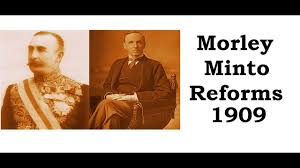Morley-Minto Reforms-Indian History Notes For W.B.C.S. Exam.
মুরলি-মিন্টো সংস্কার – WBCS পরীক্ষার জন্য ভারতীয় ইতিহাসের নোট।
- Lord Curzon had carried out the partition of Bengal in 1905. After the Bengal uprising following the partition, the British authorities understood the need for some reforms in the governance of Indians.Continue Reading Morley-Minto Reforms-Indian History Notes For W.B.C.S.
- The Indian National Congress (INC) was also agitating for more reforms and self-governance of Indians. The earlier Congress leaders were moderates but now extremist leaders were on the rise who believed in more aggressive methods.
- INC demanded home rule for the first time in 1906.
- Gopal Krishna Gokhale met Morley in England to emphasise the need for reforms.
- Shimla Deputation: A group of elite Muslims led by the Aga Khan met Lord Minto in 1906 and placed their demand for a separate electorate for the Muslims.
- John Morley was a member of the Liberal government and he wanted to make positive changes in India’s governance.
Major provisions of the Morley-Minto reforms
- The legislative councils at the Centre and the provinces increased in size.
- Central Legislative Council – from 16 to 60 members
- Legislative Councils of Bengal, Madras, Bombay and United Provinces – 50 members each
- Legislative Councils of Punjab, Burma and Assam – 30 members each
- The legislative councils at the centre and the provinces were to have four categories of members as follows:
- Ex officio members: Governor General and members of the executive council.
- Nominated official members: Government officials who were nominated by the Governor-General.
- Nominated non-official members: nominated by the Governor-General but were not government officials.
- Elected members: elected by different categories of Indians.
- The elected members were elected indirectly. The local bodies elected an electoral college who would elect members of the provincial legislative councils. These members would, in turn, elect the members of the Central legislative council.
- The elected members were from the local bodies, the chambers of commerce, landlords, universities, traders’ communities and Muslims.
- In the provincial councils, non-official members were in a majority. However, since some of the non-official members were nominated, in total, a non-elected majority was there.
- Indians were given membership to the Imperial Legislative Council for the first time.
- It introduced separate electorates for the Muslims. Some constituencies were earmarked for Muslims and only Muslims could vote their representatives.
- The members could discuss budget and move resolutions. They could also discuss matters of public interest.
- They could also ask supplementary questions.
- No discussions on foreign policy or on relations with the princely states were permitted.
- Lord Minto appointed (on much persuasion by Morley) Satyendra P Sinha as the first Indian member of the Viceroy’s Executive Council.
- Two Indians were nominated to the Council of the Secretary of State for Indian affairs.
Assessment of the Morley-Minto reforms
- The Act introduced communal representation in Indian politics. This was intended to stem the growing tide of nationalism in the country by dividing the people on communal lines. The culmination of this step was seen in the partition of the country along religious lines. The effects of differential treatment of different religious groups can be seen to this day.
- The act did nothing to grant colonial self-government which was the Congress’s demand.
- The Act did increase Indian participation in the legislative councils especially at the provincial levels.
Our own publications are available at our webstore (click here).
For Guidance of WBCS (Exe.) Etc. Preliminary , Main Exam and Interview, Study Mat, Mock Test, Guided by WBCS Gr A Officers , Online and Classroom, Call 9674493673, or mail us at – mailus@wbcsmadeeasy.in
Visit our you tube channel WBCSMadeEasy™ You tube Channel
Please subscribe here to get all future updates on this post/page/category/website



 Toll Free 1800 572 9282
Toll Free 1800 572 9282  mailus@wbcsmadeeasy.in
mailus@wbcsmadeeasy.in


















































































































